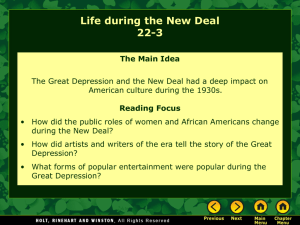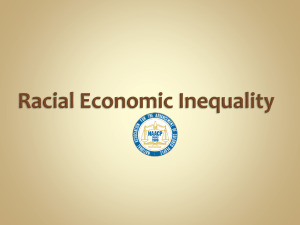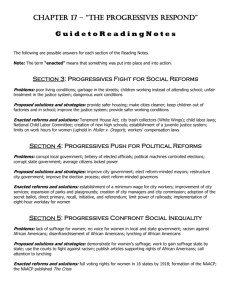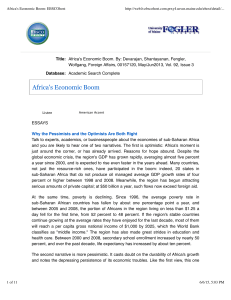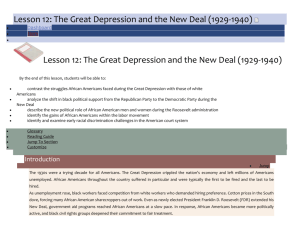The New Deal: the Good, the Great, the Bad, the Ugly
advertisement
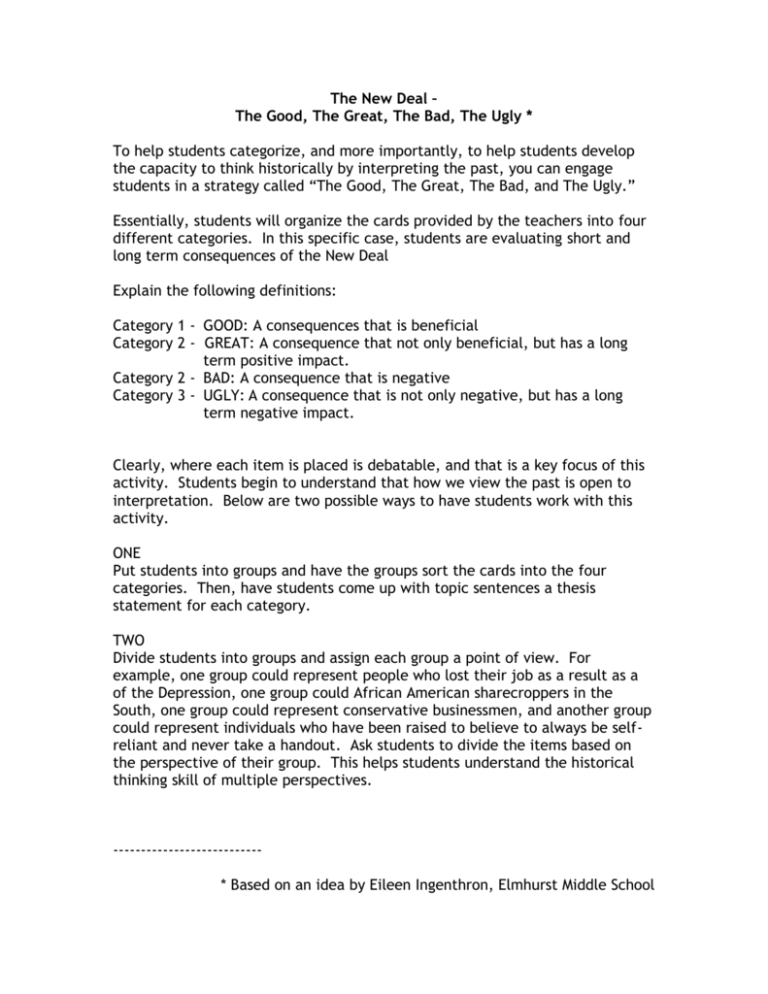
The New Deal – The Good, The Great, The Bad, The Ugly * To help students categorize, and more importantly, to help students develop the capacity to think historically by interpreting the past, you can engage students in a strategy called “The Good, The Great, The Bad, and The Ugly.” Essentially, students will organize the cards provided by the teachers into four different categories. In this specific case, students are evaluating short and long term consequences of the New Deal Explain the following definitions: Category 1 - GOOD: A consequences that is beneficial Category 2 - GREAT: A consequence that not only beneficial, but has a long term positive impact. Category 2 - BAD: A consequence that is negative Category 3 - UGLY: A consequence that is not only negative, but has a long term negative impact. Clearly, where each item is placed is debatable, and that is a key focus of this activity. Students begin to understand that how we view the past is open to interpretation. Below are two possible ways to have students work with this activity. ONE Put students into groups and have the groups sort the cards into the four categories. Then, have students come up with topic sentences a thesis statement for each category. TWO Divide students into groups and assign each group a point of view. For example, one group could represent people who lost their job as a result as a of the Depression, one group could African American sharecroppers in the South, one group could represent conservative businessmen, and another group could represent individuals who have been raised to believe to always be selfreliant and never take a handout. Ask students to divide the items based on the perspective of their group. This helps students understand the historical thinking skill of multiple perspectives. --------------------------* Based on an idea by Eileen Ingenthron, Elmhurst Middle School CARD A CARD B Through the New Deal workers in most industries were guaranteed the right to collective bargaining and to being represented by a union. The New Deal created the Social Security program, establishing a system of old age pensions. CARD C CARD D Under the New Deal, African Americans employed by the federal government jumped from 50,000 in 1933 to 150,000 in 1941. Under the Agricultural Adjustment Act (AAA), the federal government sought to aid farmers by paying them not to grow food. CARD E CARD F Under the Social Security Act employers and employees were required to contribute through a payroll tax. Through the New Deal the federal government was more involved in the daily economic lives of its citizens. CARD G CARD H The New Deal did not end the Great Depression. Many New Deal programs discriminated against African Americans as they were implemented around the country, particularly in the South. CARD I CARD J Through the New Deal the government was committed to assisting the poor and unemployed through welfare and job programs. After the New Deal, Americans began to look more directly to the federal government for economic support in hard times. CARD K CARD L Through the Works Progress Administration (WPA) the federal government hired people to build highways, public buildings, and parks. Though the programs devised for the early years of the New Deal were intended to be temporary, they provided a basis for later social measures that became part of a permanent welfare state. CARD M CARD N President Johnson’s “Great Society” programs of the 1960s enacted federal legislation that built upon and expanded economic-security programs that the New Deal had begun in the 1930s. The New Deal established the Civilian Conservation Corps (CCC), which employed millions of young men, mostly urban, to work in camps at national parks and forests on conservation and reforestation projects. CARD O There was a racial quota that limited the number of black youth in the CCC according to the proportion of blacks in the population. Since a larger proportion of black families than white families were on relief, the quota severely limited the participation of black youth. CARD P New Deal economic and financial reforms have help stabilize the nation’s economy. Although we still go through economic hard times people’s savings are insured and can receive unemployment if they lose their jobs. CARD Q CARD R Many people argue that FDR saved American capitalism through the New Deal, when people might have turned to socialism as a solution to the nation’s economic problems. The attitude of blacks toward the New Deal was summed up by a group of black social workers who visited Hyde Park in 1939: "For the first time Negro men and women have reason to believe that their government does care." CARD S CARD T By 1936 the Supreme Court had found both the AAA and NRA unconstitutional, and many New Deal supporters believed that the court would soon strike down other reformist legislation. More than any previous administration, it appointed African Americans to meaningful government positions. This in one explanation for the for African Americans switch from the "party of Lincoln (Republicans)" to the Democratic party. CARD U CARD V To correct what they saw as a lack of economic regulation and federal oversight, from 1933 to 1935 the New Dealers inaugurated a series of reforms of the banking and financial industries. The reforms were designed to systematize investing and banking, prevent fraud, and assure investor confidence. CARD W When the NRA was struck down by the Supreme Court, Congress passed the Wagner Act, which continued the right to bargain collectively, authorized the FairLabor Standards Act, which continued the forty-hour workweek and prohibited child labor, and established the National Labor Relations Board to mediate industrial disputes. Believing that a primary cause of the Depression was the low wages of workers, the New Dealers sought to raise wages, limit hours, and improve working conditions. CARD X The increased power of labor unions, welfare programs, and progressive taxation combined to increase vastly the spending power of average Americans, but the effects of such policies would not really be apparent until after World War II. CARD Y CARD Z The Civilian Conservation Corps was one of the most enduring and popular New Deal work-relief programs, lasting until the 1940s. It served three purposes. It provided relief to young men and their families; it removed young people from the private labor market; and it provided basic education and job training. What really ended the Depression was the money spent by the government and the jobs needed to fight World War II.



